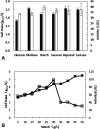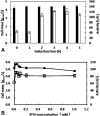Efficient synthesis of Ibrutinib chiral intermediate in high space-time yield by recombinant E. coli co-expressing alcohol dehydrogenase and glucose dehydrogenase
- PMID: 35516114
- PMCID: PMC9059822
- DOI: 10.1039/c8ra08100j
Efficient synthesis of Ibrutinib chiral intermediate in high space-time yield by recombinant E. coli co-expressing alcohol dehydrogenase and glucose dehydrogenase
Abstract
The production of (S)-N-boc-3-hydroxy piperidine (NBHP) via asymmetric bioreduction of 1-boc-3-piperidinone with reductase is impeded by the need for expensive coenzymes NAD(P)H. In order to regenerate the coenzyme in situ, the gene of alcohol dehydrogenase from Thermoanaerobacter brockii and glucose dehydrogenase from Bacillus subtilis were ligated into the multiple cloning sites of pRSFDuet-1 plasmid to construct the recombinant Escherichia BL21 (DE3) that co-expressing alcohol dehydrogenase and glucose dehydrogenase. Different culture conditions including the medium composition, inducer and pH etc were systematically investigated to improve the enzyme production. The enzyme activity was increased more than 11-fold under optimal culture condition, from 12.7 to 139.8 U L-1. In the further work, the asymmetric reduction of 1-boc-3-piperidinone by whole cells of recombinant E. coli was systematic optimized to increase the substrate concentration and reaction efficiency. At last, S-NBHP (>99% ee) was prepared at 500 mM substrate concentration without external addition of cofactors. The conversion of S-NBHP reached 96.2% within merely 3 h, corresponding a high space-time yield around 774 g L-1 d-1. All these results demonstrated the potential of recombinant E. coli BL21 (DE3) coupled expressing alcohol dehydrogenase and glucose dehydrogenase for efficient synthesis of S-NBHP.
This journal is © The Royal Society of Chemistry.
Conflict of interest statement
There are no conflicts to declare.
Figures








Similar articles
-
Efficient synthesis of (S)-N-Boc-3-hydroxypiperidine using an (R)-specific carbonyl reductase from Candida parapsilosis.World J Microbiol Biotechnol. 2017 Mar;33(3):61. doi: 10.1007/s11274-016-2189-y. Epub 2017 Feb 27. World J Microbiol Biotechnol. 2017. PMID: 28243985
-
Efficient Preparation of (S)-N-Boc-3-Hydroxylpiperidine Through Bioreduction by a Thermostable Aldo-KetoReductase.Appl Biochem Biotechnol. 2017 Apr;181(4):1304-1313. doi: 10.1007/s12010-016-2285-3. Epub 2016 Nov 16. Appl Biochem Biotechnol. 2017. PMID: 27854034
-
[Efficient biosynthesis of (S)-1-phenyl-1,2-ethanediol catalyzed by (S)-carbonyl reductase Ⅱ and glucose dehydrogenase].Wei Sheng Wu Xue Bao. 2016 Oct 4;56(10):1647-55. Wei Sheng Wu Xue Bao. 2016. PMID: 29741827 Chinese.
-
Microbial/enzymatic synthesis of chiral drug intermediates.Adv Appl Microbiol. 2000;47:33-78. doi: 10.1016/s0065-2164(00)47001-2. Adv Appl Microbiol. 2000. PMID: 12876794 Review.
-
Novel bioreduction system for the production of chiral alcohols.Appl Microbiol Biotechnol. 2003 Oct;62(5-6):437-45. doi: 10.1007/s00253-003-1347-y. Epub 2003 Jun 28. Appl Microbiol Biotechnol. 2003. PMID: 12838375 Review.
Cited by
-
Green and sustainable synthesis of chiral alcohols: the role of Daucus carota as a biocatalyst in organic chemistry.RSC Adv. 2025 Apr 15;15(15):11863-11880. doi: 10.1039/d5ra00901d. eCollection 2025 Apr 9. RSC Adv. 2025. PMID: 40236574 Free PMC article. Review.
References
-
- Chen Y. Xu Y. Chen J. B. MATEC Web Conf. 2015;22:1–5. doi: 10.1051/matecconf/20152200001. - DOI
-
- Dragutan I. Dragutan V. Demonceau A. RSC Adv. 2012;2:719–736. doi: 10.1039/C1RA00910A. - DOI
-
- Shen W. Y. Shen Z. C. Hu Z. Lin Y. L. Wang J. M. Chin. J. Pharm. 2013;44:436–437.
-
- Reddy M. S. Narender M. Rao K. R. Tetrahedron. 2007;63:331–336. doi: 10.1016/j.tet.2006.10.073. - DOI
Publication types
LinkOut - more resources
Full Text Sources

